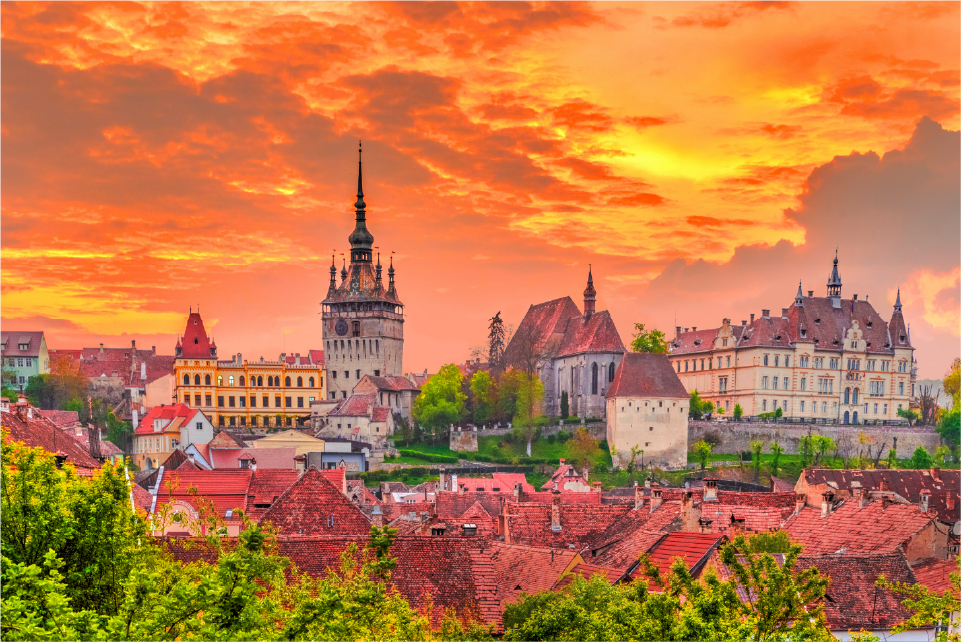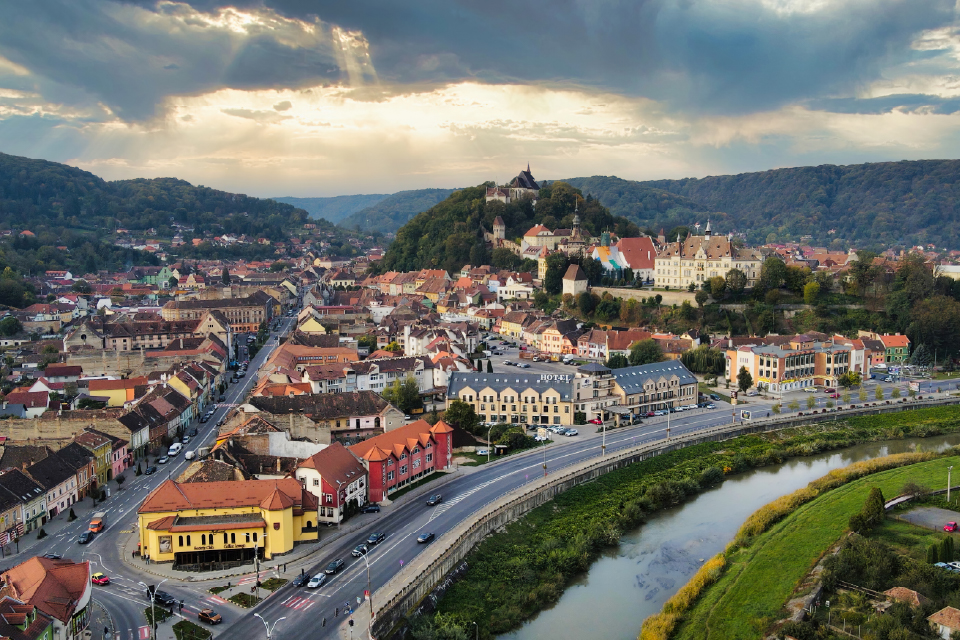
Blog

Sighișoara, this medieval fortress, with its mysterious Gothic allure, located on the banks of the river Târnava Mare, in an enchanting natural setting, with a forest surrounding the fortress on top of a hill, is documented from December 14, 1280; the Romanian name of the city being of Hungarian origin: "Segesvár"
If you go to this charming city, the Vlad Dracul House is on your way (the place where Vlad Dracul, Vlad Tepes’ father is supposed to have lived) and you can be transposed into a fascinating world, where the historical truth and mysterious legend meet.
As a tourist attraction, which helped to acquire the name "Pearl of Transylvania", we mention: the Citadel Square (one of the most beautiful medieval squares in Romania), the Clock Tower - 64 meters high (with its own legend that says that the clock in tower never lags behind), the Church on the Hill (with the beauty of its Gothic style architecture), the Covered Stairs (with its 175 steps), the Monastery Church, the Deer House and, last but not least, the brightly colored buildings that delights the eye.
In the Medieval Fortress of Sighișoara, which is also among the few permanently inhabited medieval fortresses in Europe, everything is like a fairy tale if we set our imagination in motion: narrow streets where fearless knights and ladies roamed, waiting to be saved, rulers and their ladies who lived in medieval buildings, with Baroque, Gothic and Renaissance architecture, in sumptuous rooms with solid wood furniture, drummers (the openers of the Citadel) dressed as in the old days.
Nowadays, we find another drummer, other knights and other ladies, this time at the famous Medieval Festival, which attracts tens of thousands of tourists every year, from the country and abroad, eager for joy.
Fairy tales are more beautiful when they come true, so the story goes on, through Sighișoara Shop.
We try to carry on the beauty of this picturesque city along with its special traditions through thematic-traditional products and in collaboration with local producers.
Therefore, we warmly invite you to visit our store and buy products that tell the story of this special city, from the heart of Transylvania.

1. The citadel served as the administrative, legal, cultural, and spiritual center of the settlement throughout the Middle Ages; it housed the town hall, churches and monasteries, the parochial house, schools, and the residences of the patriciate.
2. Between 1431 and 1436, Wallachian prince Vlad Dracul established his "watch nest" in Sighișoara, a city from which he issued coins bearing his own effigy.
3. In 1431, his son Vlad Tepes Draculea was born.
4. The first population census of Sighișoara shows that in 1488 the city had 600 households, 20 free peasants, 3 public officials, 2 millers, 9 poor people, and 5 herdsmen.
5. The most famous graduate of the School on the Hill was the scientist Hermann Oberth (1894-1989), the creator of the rocket engine and a titan of space navigation.
6. In December 1999, Sighișoara was added to the UNESCO World Heritage list.
7. Sighișoara is divided into the old town or Upper Town (the Citadel), and at the foot of the Citadel lies the Lower Town, a former medieval district.
8. Out of the 14 defense towers of the Citadel, only 9 are preserved: the Clock Tower, the Blacksmiths' Tower, the Shoemakers' Tower, the Tailors' Tower, the Tanners' Tower, the Butchers' Tower, the Ropemakers' Tower, the Tinmakers' Tower, and the Furriers' Tower.
9. Five towers have disappeared over time: the Coopers' Tower, which was replaced by the current Town Hall; the Weavers' Tower; the Locksmiths' Tower, which was replaced by the Roman Catholic Church; the Goldsmiths' Tower, which was replaced by the mortuary chapel belonging to the Church on the Hill; and the Bricklayers' Tower, which was located between the Clock Tower and the Tanners' Tower.
10. Sighișoara is the only permanently inhabited medieval citadel in Southeastern Europe.

If you stay a few days in Sighișoara and want to visit the main tourist attractions and museums of the city, we present our itinerary, which includes detailed information about them and how to organize your time.
Tourist attractions you must not miss when you are in Sighișoara:
1. The Stag House (Casa cu Cerb), named after the stag's head fixed on the corner of the building, is a structure typical of Transylvanian Renaissance, probably dating from the 17th century. Notable features include its robust and balanced forms, the vaulted ground floor, the stone frames with dentils, and the small dormer window oriented towards the square. The Stag House (Casa cu Cerb) was restored by the Restauro Messerschmitt Association from 1997 to 2001. Currently, in the Stag House (Casa cu Cerb), you can find the Art Coloris Transilvaniae collection by the artist Rareș Kerekeș.
2. The Venetian House (Casa Venețiană), named after the stone window frames that imitate Venetian Gothic, dates back to the 16th century. It was the residence of Mayor Stephanus Mann, whose tombstone can be seen in the Church on the Hill (Biserica din Deal).
3. Situated on the eastern side of the lower plateau of the Citadel, the Clock Tower (Turnul cu Ceas) — symbol of the city — reflects the defensive effort, the desire for affirmation, and the authority of Sighișoara Citadel. The structure is based on a rectangular prism and features five levels, which, together with the balcony and pyramidal roof, reach a height of 64 meters. The History Museum of Sighișoara (Muzeul de Istorie) is located within the Clock Tower (Turnul cu Ceas).
4. In the Vlad Dracul House (Casa Vlad Dracul), one of the oldest stone buildings in the Citadel, it is believed that Vlad Dracul, the ruler of Wallachia, son of Mircea the Elder and father of Vlad the Impaler, lived.
5. In the Middle Ages, the Citadel Square (Piața Cetății) was the commercial market and the place where trials were held. Here you can find the "Pillar of Shame", a column with iron rings to which wrongdoers were tied with a 6 kg stone hanging from their necks. Take a moment to relax and enjoy a lemonade at one of the inviting terraces in the unique Citadel Square (Piața Cetății).
6. The Covered Staircase (Scara acoperită), or Scholars' Staircase (Scara școlarilor), with its 300 steps, was built in 1642. It was covered to protect the children who took this route to the Joseph Haltrich High School (Liceul Joseph Haltrich). After modifications in 1849, only 175 steps remain. As a reward for climbing these stairs, you will reach the Church on the Hill (Biserica din deal), one of the most representative Gothic ecclesiastical buildings.
7. Of the four churches that once existed within the citadel, three have been preserved: the Roman Catholic Church (Biserica Romano-catolică), the Monastery Church (Biserica Mănăstirii), and the Church on the Hill (Biserica din deal), which we warmly recommend visiting. The Church on the Hill (Biserica din deal) is the third largest church in Transylvania.
8. The Citadel Towers - The Clock Tower (Turnul cu Ceas), the Blacksmiths' Tower (Turnul Fierarilor), which hosts the permanent exhibition “Dracula Galleries,” the Shoemakers' Tower (Turnul Cizmarilor), where the local radio station is located, the Tailors' Tower (Turnul Croitorilor), the Tanners' Tower (Turnul Tăbăcarilor), the Butchers' Tower (Turnul Măcelarilor), the Ropemakers' Tower (Turnul Franghierilor), currently serving as the residence of the cemetery guard, the Tinmakers' Tower (Turnul Cositorarilor), and the Furriers' Tower (Turnul Cojocarilor).
Where to stay in Sighișoara:
1. Casa Savri - This historic monument is the oldest building in the citadel, dating back to 1568. Located on Ulița Morii, Casa Savri is considered part of the UNESCO World Heritage. Each room has a unique style, preserving its old charm while also incorporating all modern amenities. The inner courtyard and outdoor terrace are decorated with flowers and traditional colors, and if you follow the interior stairs, you will eventually reach the Town Hall (Primăria Sighișoara) and the famous Clock Tower (Turn cu Ceas).
2. Taschler Boutique Hotel - Born in the 1670s, this Saxon house is located just 150 meters from the citadel's symbol, the Clock Tower (Turnul cu Ceas). The hotel has 10 rooms, each with its own story and showcasing the trades of Saxon craftsmen. At the entrance, under the archway, you will find the peasant courtyard, decorated with traditional elements of Saxon life and their household activities. Another place of interest is the cellar, which contains objects and symbols from traditional Saxon households, as well as hand-painted artworks.
Recommendations for restaurants in Sighișoara:
1. Restaurant Casa Joseph Haydn - Wine & Cuisine, located at 10 Bastion Street, is a refined, classic, and elegant restaurant.
2. Restaurant Casa Georgius Krauss is a traditional and international restaurant, located in the Citadel at strada Bastionului 11.
3. Restaurant Casa Ferdinand is always a great choice when visiting Sighișoara. Located at the base of the Citadel, this restaurant has a charming terrace and serves the best pizza in town.
If we've sparked your interest and you wish to spend a few enchanting days, Sighișoara is waiting for you to discover it.
